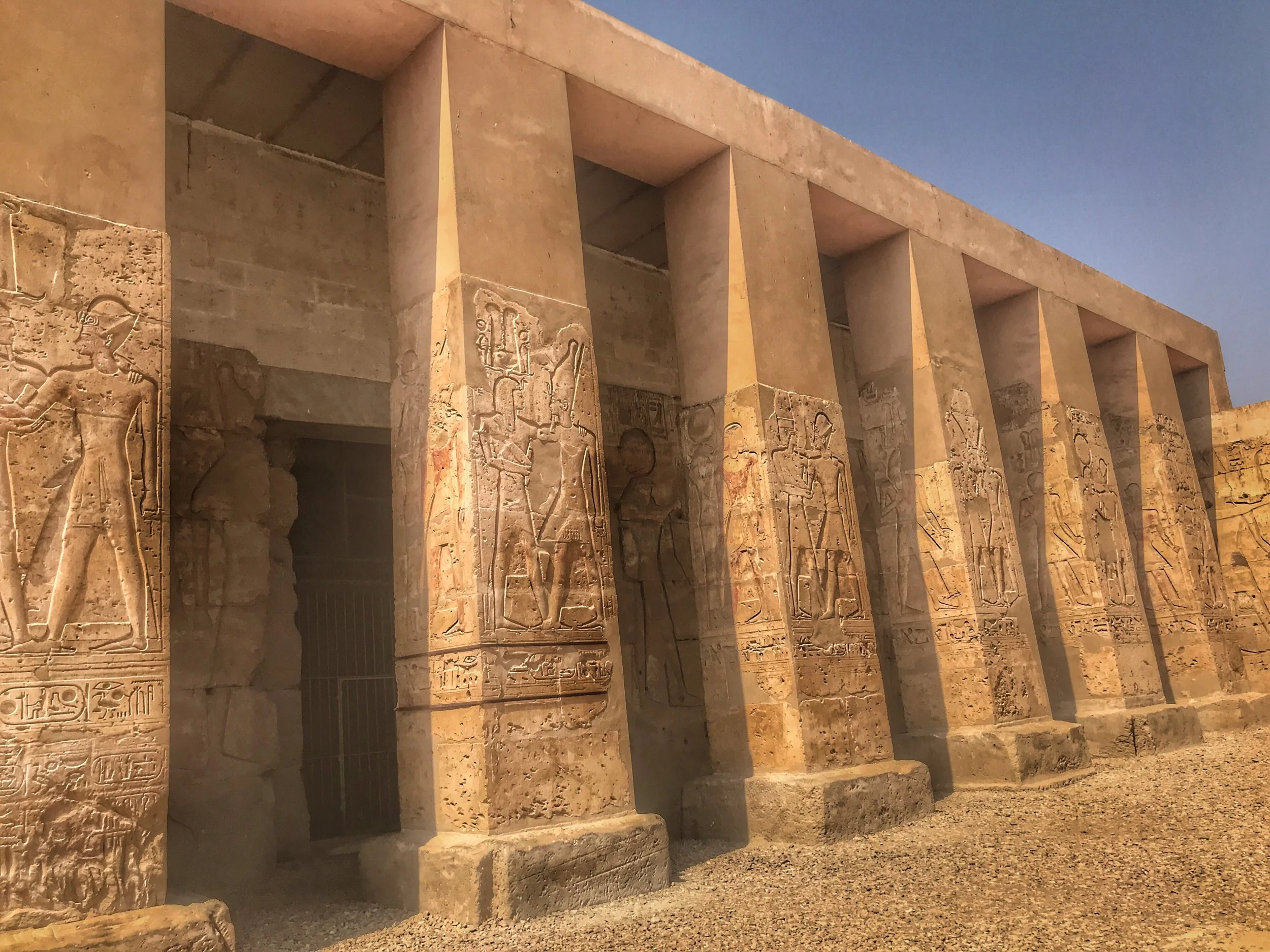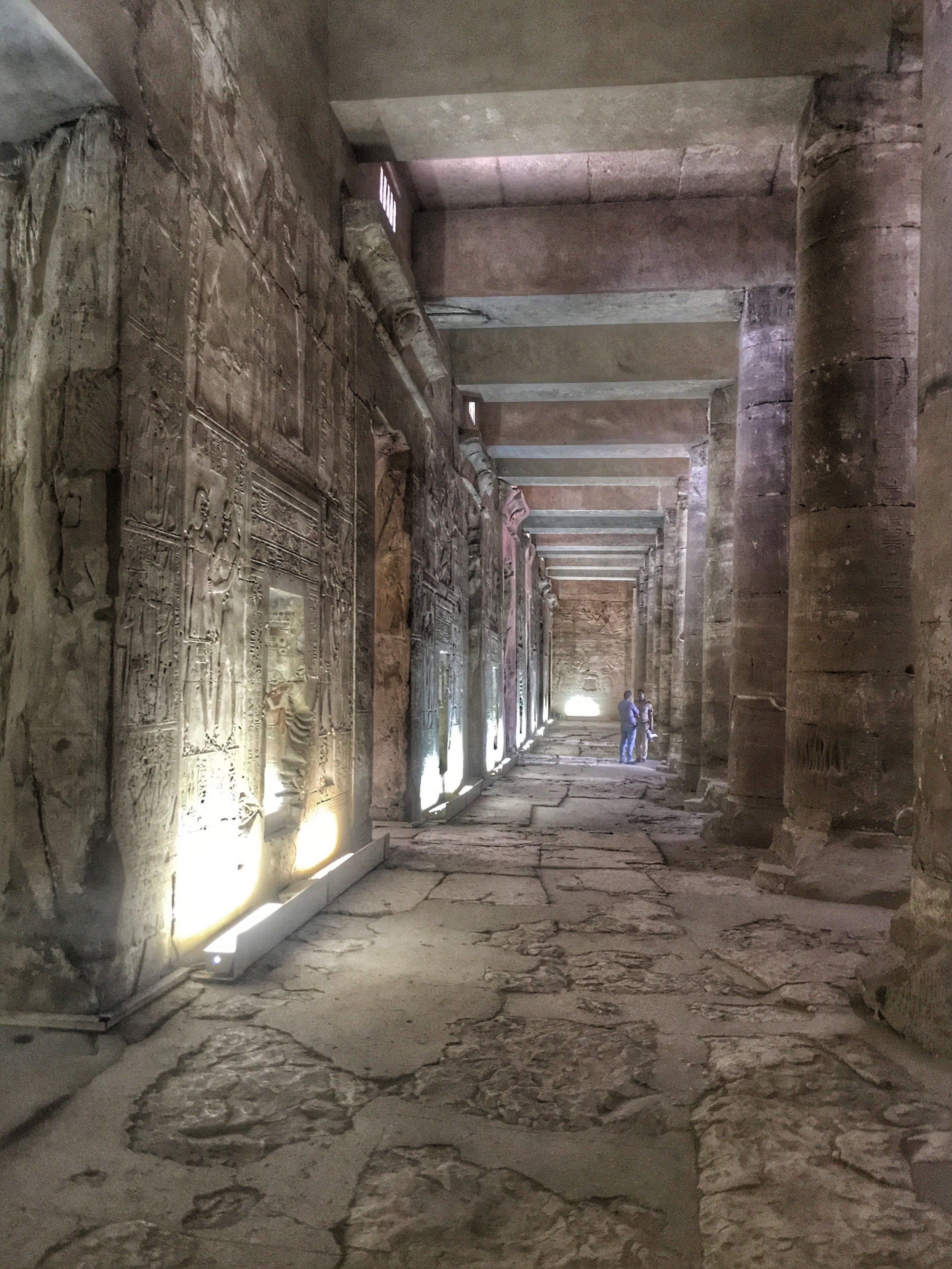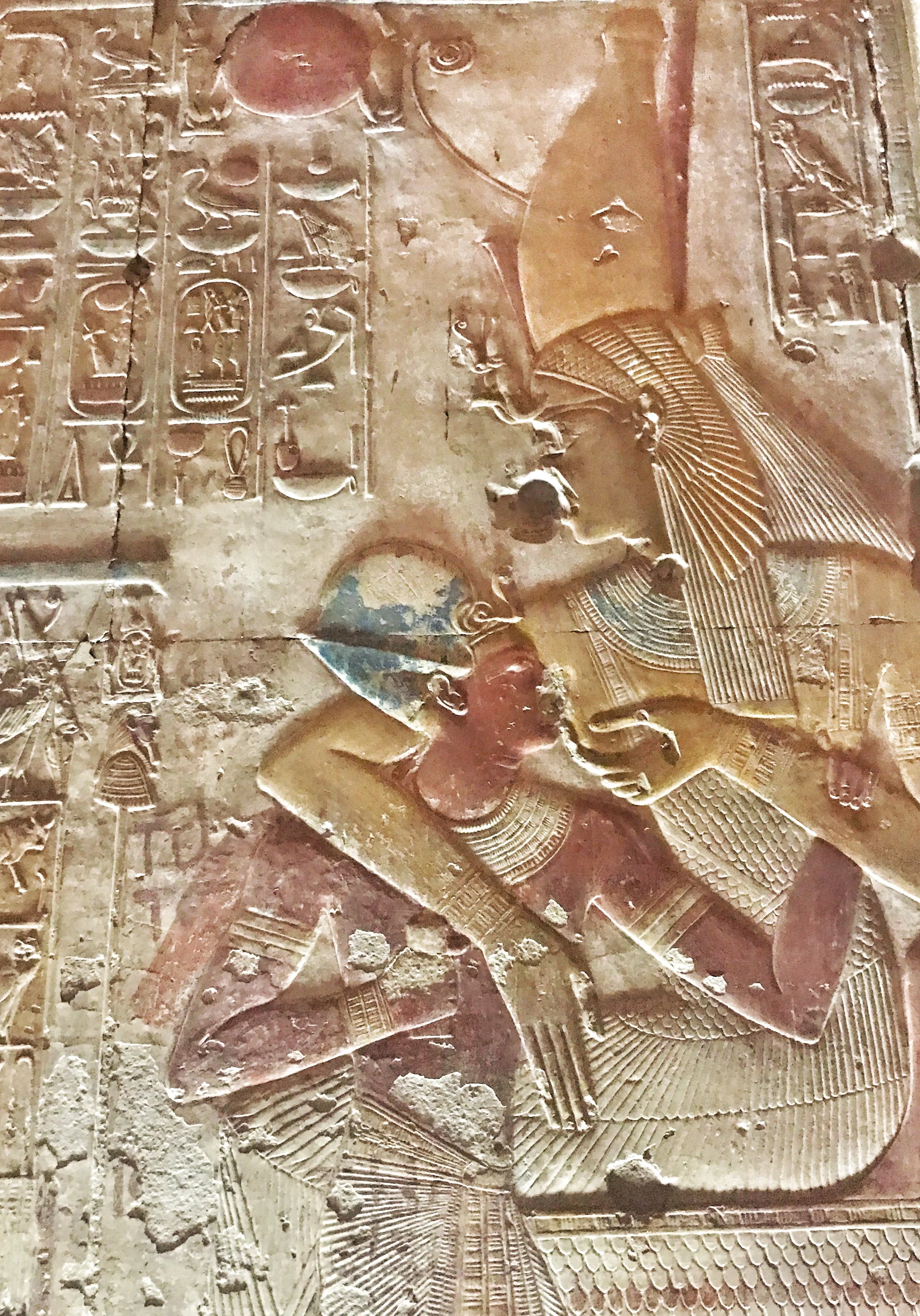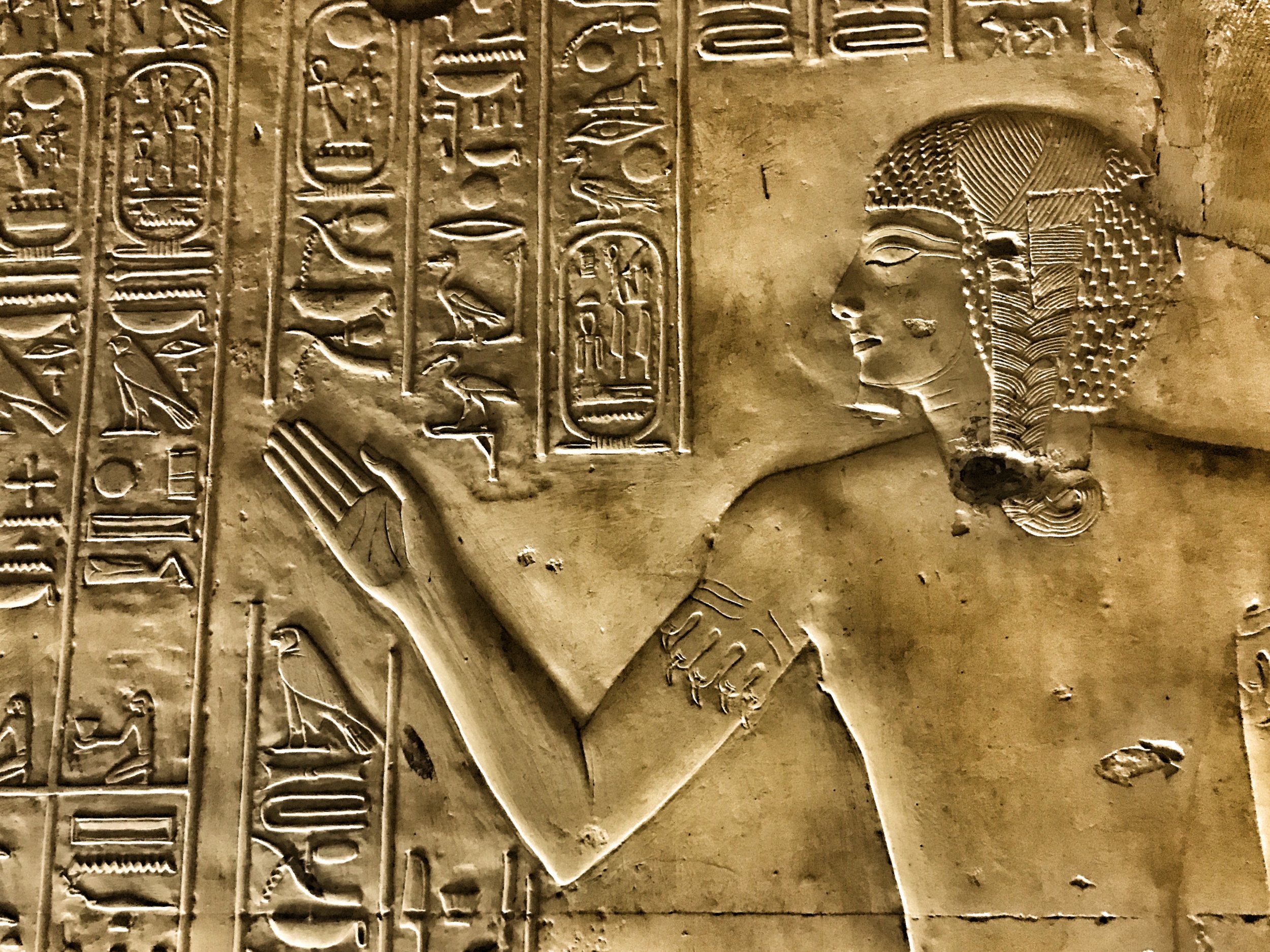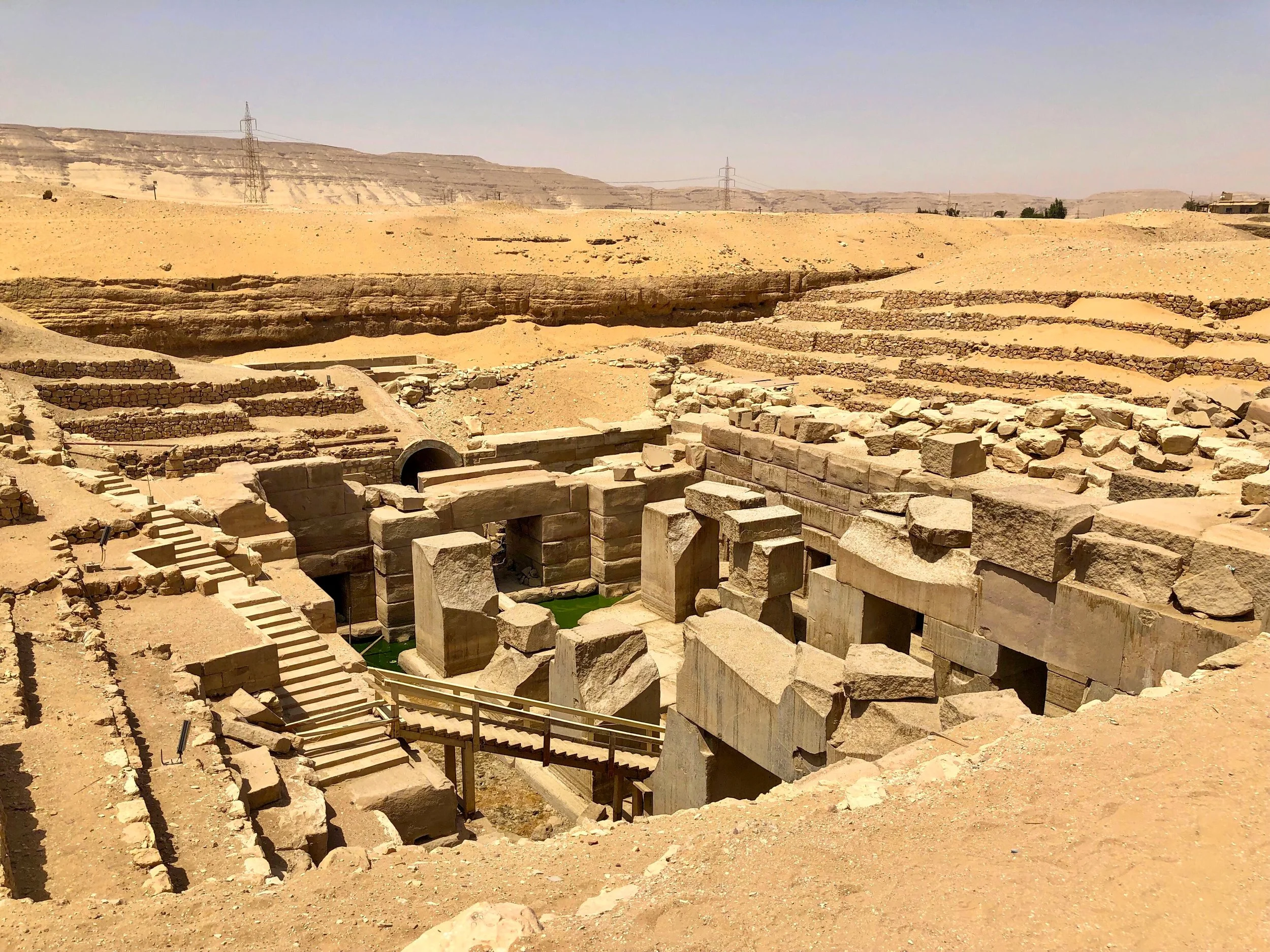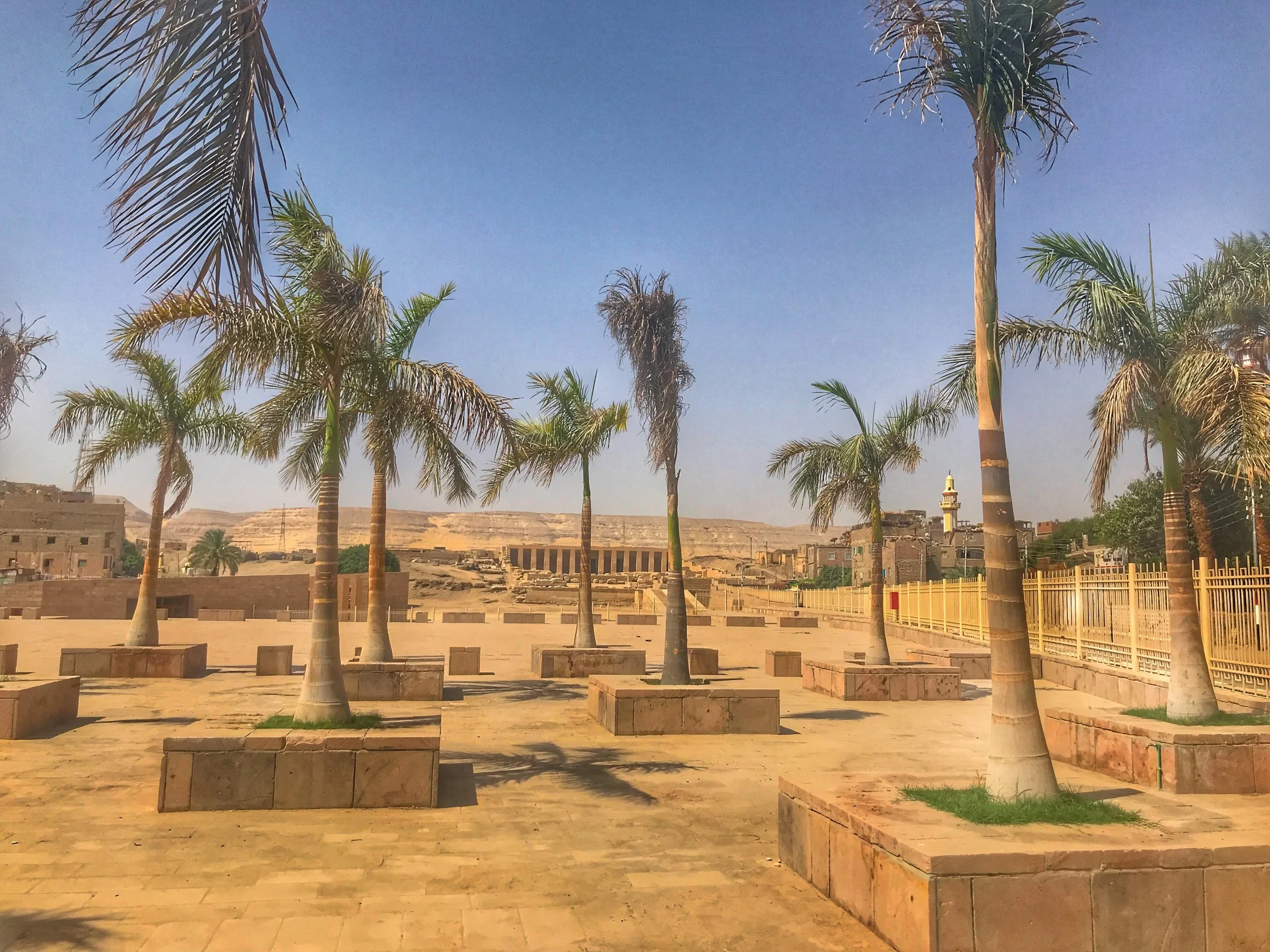This overlooked Temple of Seti I and Ramesses II is a heavenly day trip from Luxor.
Heavenly rays of light shine through the dark temple, making it feel even more spiritual
Our guide, Mamduh, told us he has been all over Egypt and has explored all the major temples — and yet the only one that felt truly spiritual to him was Abydos.
Duke and I can understand this. Maybe it’s the cool, dark colonnades, with beams of sunlight shining through like a celestial cliché. Or perhaps it’s the fact that there’s not one but seven sanctuaries, each devoted to a different god. It all works together to create something eternal and sacred. The site is also off the main tourist track, and aside from one small tour group, we had the place to ourselves.
“The earliest pharaohs were buried here, as far back as 3000 BCE.
Later, Abydos became a center of the cult of Osiris, the god of the underworld. People believed his tomb was here.”
The clean lines of this holy site feel modern, even though the temple is 3,200 years old!
Burial Site of Osiris and the First Pharaohs
The location, in the Sohag Governorate of Upper Egypt, was known in ancient times as Abdju and has been held as sacred from the beginnings of the Egyptian state. It’s said to be the birthplace of the god Osiris, and it’s where his decapitated head was buried by his murderous brother Set.
Wally and Mamduh from Egypt Sunset Tours make the pilgrimage to Abydos
Abydos is the holiest of necropolises; during pharaonic times, Ancient Egyptians wanted to be buried here, and at one point, everyone tried to make it here on pilgrimage at least once in their lives. (If that didn’t pan out, they often depicted the journey in their tombs. Better late than never.)
The earliest pharaohs were buried here, as far back as 3000 BCE. Later, Abydos became a center of the cult of Osiris, the god of the underworld. People believed his tomb was here, though evidence points to it actually being the final resting place of a First Dynasty pharaoh, Djer.
Ramessess II added a front section to his father’s temple
Temple of Seti I and Ramesses II
Abydos, like so many Egyptian temples, was really an ongoing construction project, with various kings adding structures here, repurposing materials there.
King Seti I built a large complex at Abydos some 3,200 years ago to show he honored the Egyptian pantheon (and to show that he, too, was divine). A belief in the old gods was especially important to prove after the radical Pharaoh Akhenaten departed from centuries of tradition and enforced monotheism, celebrating a single deity known as Aten, the sun disk. (Spoiler alert: It didn’t go over well.)
You can tell the parts of the temple that were added by Ramesses II because the depictions are carved into the stone rather than being proper bas-reliefs
As we approached the temple, we paused on the open terrace to admire the precise horizontal and vertical symmetry of its exterior, which, like Hatshepsut’s funerary temple, feels modern in its minimalism.
In the first courtyard, on the second pylon wall, are scenes of Ramesses II’s military victories, including the Battle of Kadesh, which is also shown at Abu Simbel. I use the term “military victories” loosely. This is an example of the pharaoh’s fondness for revisionist history: The Battle of Kadesh ended in a stalemate.
Farther in, the columns and walls of the Temple of Seti I boast of his deeds as well as those of his son and heir, Ramesses II.
Wally and Duke highly recommend adding Abydos to your itinerary
Mamduh, who works with Egypt Sunset Tours, stopped in front of a wall covered with cartouches, oval carvings containing hieroglyphics that represent the names of pharaohs. “This is why we know all of the dynasties and the order of the pharaohs,” he told us. The names were a long list of Egyptian kings in chronological order, going all the way back to Menes, the legendary founder of the empire, credited with the unification of Upper and Lower Egypt, and continuing all the way to Seti I.
The Kings List depicts the cartouches of all the pharaohs, with some notable omissions, including Hatshepsut and Akhenaten
Known as the Abydos King List, the relief conspicuously skips over some problematic rulers: the century-long reign of the foreign invaders, the Hyksos; the female pharaoh Hatshepsut; and the heretical Akhenaten and his three short-lived successors. Again, we see that Ancient Egyptians made revisionist history a literal art form.
Abydos isn’t one of the more popular tourist destinations — which makes it all the more special to visit
As we continued to wander through, Mamduh pointed out a set of unusual-looking hieroglyphics carved into a lintel overhead. A mysterious set of symbols appear to depict a helicopter, a submarine and a dirigible-like airship. Did they predict the future?!
I’m not one to crush anyone’s conspiracy theory dreams, but these images are actually the result of surfaces that have been reused. Over time, bits of the lime plaster eroded, leaving a partially visible set of overlapping glyphs. The initial set of carvings were made during the reign of Seti I and were later altered with plaster and re-carved during the temple’s expansion by his son.
Seti I built this as his funerary temple. He chose a throne name that didn’t reference Set, the murderous god of chaos
Most temples have a single sanctuary, or holy of holies — but Abydos has seven!
The Seven Sanctuaries
At the back of the second hypostyle hall are seven barrel-vaulted sanctuaries dedicated to different deities: Horus, Isis and Osiris, with the principle god Amun in the middle, then Re-Horakhty, Ptah and the deified Pharaoh Seti I.
The lion-headed goddess of war, Sekhmet, is the wife of Ptah, god of architects and craftspeople
Anubis, the god of the dead, with Seti I
Most temples have a single sanctuary, known as the holy of holies. So perhaps the fact that Abydos has seven is a large part of what lends a spiritual air to this sacred space. Six have false doors to allow the ka, or soul, to pass through. The exception is the sanctum of Osiris, whose chamber has a doorway leading to a suite of rooms — as Mamduh pointed out, the god of the underworld can travel between both worlds.
Ancient Egyptians believed that a scarab, or dung beetle, pushed the sun through the sky
Isn’t he getting a bit old for that? A young Ramesses II suckles on the goddess Isis’ breast
Wooden ships known as barques, or solar boats, originally stood in each of the sanctuaries. They were believed to carry the deities across the heavens and were used to transport the statue of the god in ritual processions.
When you see a boy with a braided side ponytail like this inside the temple, that’s Prince Ramesses II
The Osiris Sanctuary, just one of seven at Seti I’s temple at Abydos. Osiris is depicted with green skin
Head out the back door to walk past the Osirion
Out back, behind the temple proper, are the ruins of a primitive-looking structure built in the form of a royal tomb. Known as the Osirion, the cenotaph (a fancy word for a monument to someone whose body is buried elsewhere) is thought to be for Osiris. It was closed when we were there — though it doesn’t look like we missed much, aside from sunken granite blocks surrounded by pools of toxic-looking green water.
The sunken ruins of the Osirion, a tomb to honor the god of the underworld
We visited Abydos as a day trip from Luxor, pairing it with the amazing Dendera. These less-visited sites are often the most unexpected, special and spiritual.
Duke and I were fortunate to have Rasha from Egypt Sunset Tours arrange excursions that suited us so well. If you want to experience the magic of Egypt like we did, book your tours through them. –Wally
The strikingly modern visitors center works as a visual reference to the temple’s façade
The temple at Abydos is seen in the distance




